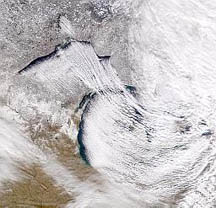Air mass modification
The arrows in Figure 8.2 indicate the trajectory that
air masses affecting North America take as they move out of their source
regions. As they traverse the surface, the temperature and moisture content
of air masses are modified. Continental air masses traveling south out of central
Canada move over warmer surfaces. To indicate that the air mass is
colder than the surface over which it is traveling a "k" is
added (cPk). Heat transfer into the air mass from
the underlying surface creates unstable conditions. In the late fall and
early winter cP air masses moving over the open water of the Great Lakes
gain heat and moisture. As the air mass strikes the land, the air can be uplifted by topographic
barriers causing the
lake-effect snows
Off the southwest coast of North America lies a source region for maritime tropical air. This air mass is typically unstable at its source. As it moves toward land the air passes over the cold California Current. As the air mass traverses the cold ocean current, heat is transferred out of the air mass near the surface. In addition, the subsidence of the air aloft due to the presence of the subtropical high in this region causes adiabatic warming of the air at higher elevations. As a result, the environmental lapse rate of temperature decreases or sometimes inverts, making the air stable. To show that the air mass has become stable an "s" is added to its abbreviation, e.g. mTs. Stable conditions inhibit uplift and reduce the possibility for precipitation. Conversely, off the east coast of the United States the warm Gulf Stream enhances the instability of the maritime air mass and precipitation becomes more likely. In this case, a "u" is added to indicate that the air mass is unstable, e.g. mTu. |

 Figure 8.3 Cloud
formation and lake effect snow over Lake Superior and Lake Michigan
Figure 8.3 Cloud
formation and lake effect snow over Lake Superior and Lake Michigan